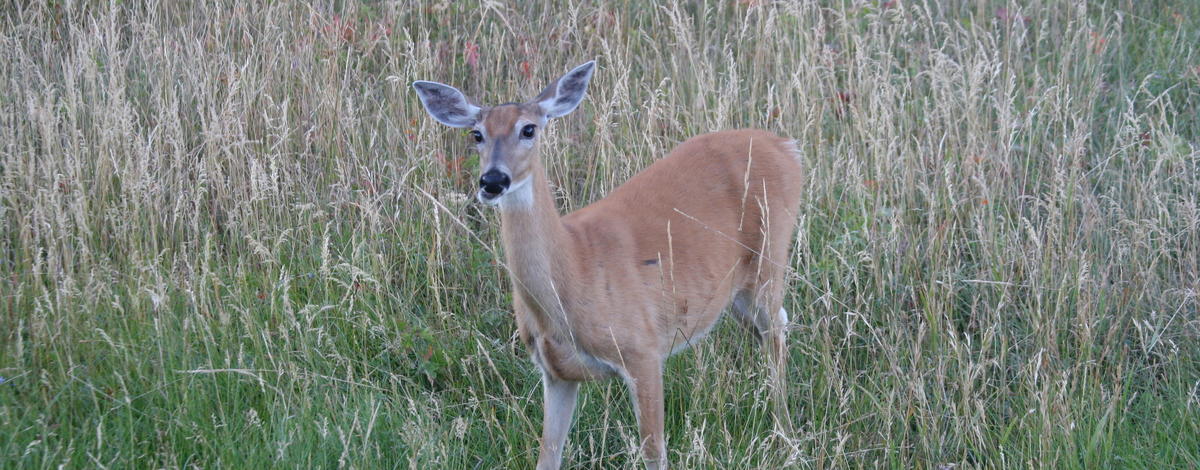Fish and Game wildlife staff continues to monitor the extent of the disease causing deer to die across the region. Multiple samples taken from dead deer across the Clearwater Region have come back positive for the Epizootic Hemorrhagic Disease (EHD) virus.
Outbreaks of EHD are not uncommon to white-tailed deer. Wildlife staff anticipated the potential for a disease outbreak due to this year's extended hot and dry weather pattern. This summer created ideal conditions for deer to congregate at water sources where the disease-carrying biting gnat resides. The number of dead deer is expected to continue to increase a week or more after a first hard frost kills gnat populations.
The following are frequently asked questions regarding EHD. For more information, contact the Clearwater regional office at (208) 799-5010.
Q: What are clinical signs of EHD in deer?
A: Clinical signs include sluggishness, difficulty breathing, and swelling of the head, neck and tongue. Ulcers or erosions of the tongue or gums may be present. Internal lesions include swelling and fluid accumulation in the lungs, ulcers in the abdomen and hemorrhages on the heart and intestines. Animals with chronic EHD can have abnormal hoof growth, hoof sloughing and sometimes are emaciated. Infected deer can also lose their appetite, become weak, can have bloody diarrhea, and show excessive salivation. They develop a rapid pulse and respiration rate along with fever, which is why they are frequently found lying in bodies of water to reduce their body temperature.
Q: How is EHD spread?
A: Hemorrhagic diseases can be spread to deer via the bites of Culicoides gnats (biting midges, no-see-ums) or deer to deer. Low water conditions and stagnant pools and ponds provide ideal breeding conditions for the gnats that transmit EHD. No prevention methods exist. Deer death numbers are likely to continue to increase until the weather cools and a hard frost kills biting gnat populations.
Q: What time of year is EHD usually observed?
A: Hemorrhagic diseases are not uncommon to the Clearwater region. Epizootic Hemorrhagic Disease outbreaks usually occur in late summer or early fall when warm and dry conditions cause animals to congregate at limited water supplies where the gnats also like to breed.
Q: Can EHD be spread to humans or pets?
A: Humans and domestic pets such as dogs and cats cannot be infected with the EHD disease. White-tailed deer are particularly susceptible, but it can affect mule deer. Cattle and sheep can be exposed to the virus, but they rarely exhibit clinical signs to the varieties of EHD that typically affect wildlife.
Q: What is the impact to deer in our area? How will this affect my hunting season?
A: We do not know yet. Big game hunters should have good hunting for 2021, but there are some disease concerns. As of now, we estimate that several hundred if not up to a thousand or more deer have died in the Clearwater Region. It is anticipated the death toll will increase into the next month or so until we experience cold enough weather conditions to kill the disease carrying gnat. Fish and Game is monitoring the disease closely and will assess deer numbers as disease issues subside.
Q: Is the meat of an EHD infected deer safe to eat?
A: Our veterinary staff never recommends eating an animal with a fever and a widespread systemic infection. Deer that survive an EHD infection are safe to eat. These animals may exhibit a dark gritty liver. Our veterinary staff always recommends thoroughly cooking all game meat.
Q: What is Fish and Game doing to monitor the disease?
A: Fish and Game veterinarians and biologists are monitoring the extent of this disease. Fish and Game asks the public to contact the wildlife health lab online at https://idfg. idaho.gov/conservation/wildlife-health/add to report sick and injured wildlife.
Q: If I have a dead deer on my property, what do I do?
A: At the expense of Idaho Fish and Game, dead deer can be taken to the following locations;
Simmons Sanitation, 3226 Highway 12 Kamiah, ID (208) 935-2617
Latah Sanitation, 3299 Hwy 8, Moscow, ID (208) 882-5724
Clearwater County Transfer Station, 585 Transfer Station Rd. Orofino, ID 83544 (208) 476-7903
Timberline Container Site, 3913 Hjalmar Johnson Rd., Weippe, ID 83553 (208) 435-4965
Fish and Game encourages neighbors to help neighbors. If you or you know of someone that has a dead deer on their property, please assist them with removal.
Q: What can I do to help?
A: Dead deer can be taken to one of the disposal locations listed above at the expense of Fish and Game. Idaho Fish and Game officers are stretched thin and are not able to keep up with all the reports. Please assist your friend or neighbor with disposing of animals that they may have on or near their property.
Please report dead or sick deer online at the Wildlife Health webpage. Contact Idaho Fish and Game Clearwater region office for more information (208) 799-5010.

